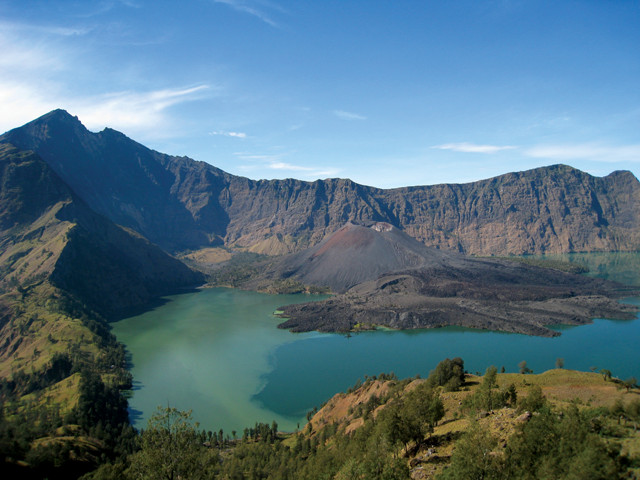
by Kate S. Zalzal Wednesday, April 19, 2017

Lake Segara Anak fills the caldera formed during Samalas' 1257 eruption. Credit: Petter Lindgren.
The A.D. 1257 eruption of the Indonesian volcano Samalas sent an ash plume an estimated 43 kilometers into the sky in one of the most sulfur-rich eruptions of the last 7,000 years. A new study using tree rings, ice cores and historical records investigates how this colossal eruption impacted climate across the Northern Hemisphere, finding that the eruption triggered severe cold in some regions, while other areas were less affected. The pattern could be explained by the behavior of sulfate particles in the atmosphere, researchers suggest.
Scientists have known for decades that a large, sulfur-rich volcanic eruption, likely in the tropics, was responsible for the massive sulfate spikes seen in both Arctic and Antarctic ice cores. But it wasn’t until 2013 that Samalas Volcano was determined to be the culprit, and its eruption year confirmed as 1257. Its climatic impacts, however, continue to be debated.
“Given the cooling effects of the 1991 Pinatubo eruption, some scientists thought that a larger, more sulfate-rich eruption, such as Samalas, would lead to a widespread and prolonged temperature decrease,” says Markus Stoffel, a dendrochronologist at the University of Bern in Switzerland and co-author of the new study in Nature Geoscience. But previous temperature reconstructions based on tree-ring analysis have indicated a more varied response.
The new study relies on ice-core data and additional tree-ring records along with European medieval texts and records of grape harvest dates from France in order to better understand Samalas’ impacts. Lead author Sébastien Guillet, a doctoral student at the University of Bern at the time of the research, found 35 written accounts of significant climate anomalies across Western Europe in 1258, including cold temperatures, incessant rainfall and extreme cloudiness. Exceptionally late grape harvest dates corroborate the occurrence of a cold summer in Western Europe; records indicate that winemakers held off harvesting in late summer as they were hoping for warmer conditions in autumn that would help the fruit reach maturity.
Researchers also analyzed 25 Northern Hemisphere tree-ring chronologies, which showed profound cooling. The summers of 1258 and 1259 appear to be the coldest consecutive two-year period during the past millennium. The cooling was most apparent in Siberia, Central Asia, Western Europe and the Canadian Rockies. Japanese historical records also indicate cold and wet conditions in Japan the year after the eruption. In contrast, ice-core data and tree-ring records from Greenland, northeast Canada and Alaska do not reveal such pronounced cooling.
“Volcanic eruptions apparently do not cause a uniform and homogenous climate signal,” Stoffel says.
The researchers suggest the key to the variability in climate response may lie in the microphysics of aerosols. Despite the release of greater volumes of sulfur, particles from large eruptions tend to aggregate more, growing in size and mass until they are washed out of the atmosphere, Stoffel says, limiting both the severity and the duration of any eruption-induced cooling. This work further demonstrates that “there is no simple linearity between the sulfur released and the temperature impact [of an eruption],” he says.
The volcanic aerosols also perturb the atmosphere’s thermal structure, says Joe McConnell, a paleoclimatologist at the Desert Research Institute in Reno, Nev., who was not involved in the study. This, in turn, can alter atmospheric, and possibly even oceanic, circulation, further prompting variable climatic responses, he says.
Scientists are currently exploring the idea that a series of smaller eruptions, occurring close in time, could exert more influence on climate than a single, large eruption. The 12th and 13th centuries saw a concentration of volcanic eruptions, but most of these remain poorly constrained or not described at all, Stoffel says. “We’d like to know whether this succession of eruptions may have led to the start of the Little Ice Age.”
McConnell agrees that the physical parameters of past eruptions must be better understood in order to predict impacts of future eruptions. Numerical models are critical in this effort, he says, and they need to be validated against high-resolution paleoclimate data from both natural archives and historical records. “The more we quantitatively understand how volcanic eruptions can alter climate, the better we can plan for and mitigate their impacts,” he says. “After all, it’s not a question of if there will be another such eruption, only when.”
© 2008-2021. All rights reserved. Any copying, redistribution or retransmission of any of the contents of this service without the expressed written permission of the American Geosciences Institute is expressly prohibited. Click here for all copyright requests.